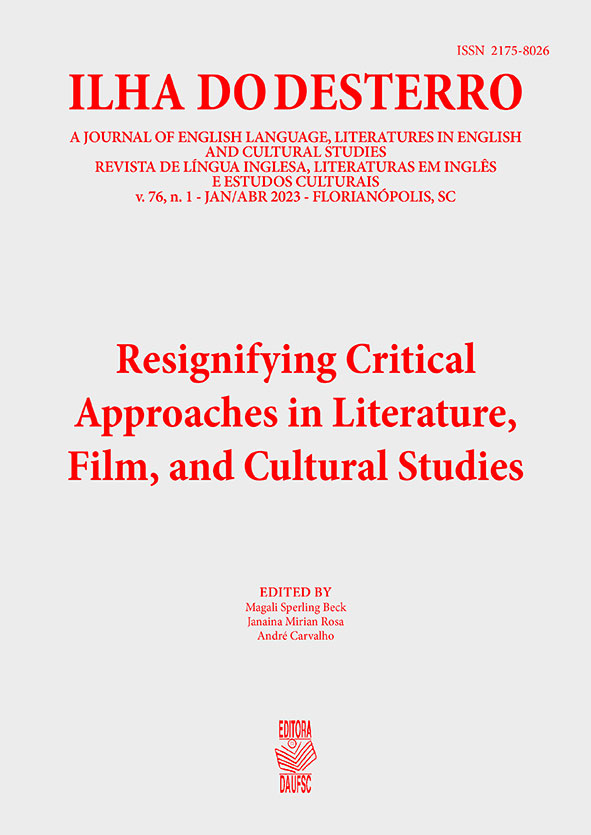Self-reflexive Anthropomorphism in Cece Bell’s Autobiographical Comics: A Study of the Transgressions of Narrative Levels
DOI:
https://doi.org/10.5007/2175-8026.2023.e87713Palavras-chave:
autobiographical comics, anthropomorphism, El Deafo, metalepsis, digital comicsResumo
Cece Bell released her autobiographical comic El Deafo (2014) in print and digital versions, transposing herself into the anthropomorphic rabbit Cece, who speaks of her hearing loss experience at four after having contracted meningitis. Young Cece wears a hearing aid on her long rabbit ears, showing her animal, human, and technological hybrid body to others. Nevertheless, she assumes the identity of the superhero “El Deafo,” her alter-ego, to cope with her daily challenges in a community composed mostly of hearing individuals, first as an escape to her imaginary world and later for accepting her identity as deaf. This paper aims to analyse El Deafo as an autobiographical comic, considering the representation of deafness through an unstable hybrid body and a transgression of the narrative levels based on the notion of metalepsis, drawn by Genette, Kukkonen, and Ryan in various media.
Referências
Bell, Cece. “Cece Bell: How I Made El Deafo—in Pictures.” The Guardian, 4 Aug. 2015, https://www.theguardian.com/childrens-books-site/gallery/2015/aug/04/cece-bell-el-deafo-in-pictures.
Bell, Cece. “CeceBellLopezAward.” YouTube, uploaded by Cece Bell, 10 June 2020. https://www.youtube.com/watch?v=ljamATw5fLU
Bell, Cece. El Deafo. Superpowered Edition, Ebook ed., Amulet Books, 2020. ComiXology.
Campbell, Fiona Kumari. Contours of Ableism: The Production of Disability and Abledness. Palgrave, 2009.
Chern, Alexander, and Michael W. Denham. “Hollywood Helps Fight the Stigma of Hearing Loss.” The Hearing Journal, vol. 75, no. 9, Sept. 2022, pp. 18-20, doi: 10.1097/01.HJ.0000874600.30744.c8.
Chute, Hillary L. Graphic Women: life narrative and contemporary comics. Columbia UP, 2010.
Couser, G. Thomas. Recovering Bodies: Illness, Disability, and Life Writing. Foreword by Nancy Mairs, Madison, 1997.
Derby, James. “Anthropomorphism in Children’s Literature or ‘Mom, My Doll’s Talking Again.’” Elementary English, vol. 47, no. 2, 1970, pp. 190–92. JSTOR, http://www.jstor.org/stable/41386644. Accessed 7 Oct. 2022.
Eisner, Will. Graphic storytelling and visual narrative. W.W. Norton & Company, 2008.
Epley, Nicholas et al. “On seeing human: a three-factor theory of anthropomorphism.” Psychological Review, vol. 114, no. 4, 2007, pp. 864-86, doi:10.1037/0033-295X.114.4.864
Gardner, Jared. “Autography’s Biography, 1972-2007.” Biography, vol. 31, no. 1, 2008, pp. 1-26.
Gardner, Jared. Projections: Comics and the History of Twenty-First-Century Storytelling. Stanford UP, 2012.
Garland-Thomson, Rosemarie. “Integrating Disability, Transforming Feminist Theory.” NWSA Journal, vol. 14, no. 3, 2002, pp. 1-32. JSTOR, www.jstor.org/stable/4316922. Accessed 1 Dec. 2020.
Genette, Gérard. Narrative Discourse. Cornell UP, 1980.
Haraway, Donna. “A manifesto for Cyborgs: Science, technology, and socialist feminism in the 1980s.” Australian Feminist Studies, vol. 2, no. 4, 1987, pp.1-42, doi: 10.1080/08164649.1987.9961538.
Hartfield, Charles. Alternative Comics: An emerging literature. UP of Mississippi, 2005.
Herman, David. “Storyworld/Umwelt: Nonhuman Experiences in Graphic Narratives.” SubStance, vol. 40, no. 1, 2011, pp. 156-81. JSTOR, http://www.jstor.org/stable/41300193. Accessed 10 Oct. 2022.
Keen, Suzanne. “Fast Tracks to Narrative Empathy: Anthropomorphism and Dehumanization in Graphic Narratives.” SubStance, vol. 40, no. 1, 2011, pp. 135-55. JSTOR, http://www.jstor.org/stable/41300192. Accessed 7 Oct. 2022.
Kersten, Sara. “‘We are Just as Confused and Lost as She is’: The Primacy of the Graphic Novel Form in Exploring Conversations Around Deafness.” Children’s Literature in Education, vol. 49, 2017, pp. 282-301, doi: 10.1007/s10583-017-9323-9
Kukkonen, Karin, and Sonja Klimek, editors. Metalepsis in Popular Culture. De Gruyter, 2011, pp. 1-21.
Kukkonen, Karin. “Metalepsis in Comics and Graphic Novels.” Metalepsis in Popular Culture, edited by Karin Kukkonen and Sonja Klimek. De Gruyter, 2011, pp. 213-231.
Kukkonen, Karin. “Metalepsis in Popular Culture: An Introduction.” Metalepsis in Popular Culture, edited by Karin Kukkonen and Sonja Klimek. De Gruyter, 2011, pp. 1-21.
Markowsky, Juliet Kellogg. “Why Anthropomorphism in Children’s Literature?” Elementary English, vol. 52, no. 4, 1975, pp. 460-66. JSTOR, http://www.jstor.org/stable/41592646. Accessed 7 Oct. 2022.
McCloud, Scott. Understanding Comics: The Invisible Art. HarperCollins, 1993.
McHale, Brian. Postmodernist Fiction. Methuen, 1987.
Papazian, Gretchen. “First Opinion: Honoring Diversity, Visual Storytelling, and Complex Friendships: Cece Bell’s El Deafo.” First Opinions, Second Reactions, vol. 10, no. 2, 2017, pp. 18-20, https://docs.lib.purdue.edu/fosr/vol10/iss2/8. Accessed 12 Oct. 2022.
Poharec, Lauranne. “Of course, I am a hero”: disability as posthuman ideal in Cece Bell’s El Deafo. Uncanny Bodies: Superhero Comics and Disability. Edited by Scott T. Smith and José Alaniz. Penn. State UP, 2019, pp. 187-203. JSTOR, doi: 10.5325/j.ctv14gpdr1.
Refaie, Elisabeth El. Autobiographical Comics: Life Writing in Pictures. UP of Mississippi, 2012.
Ryan, Marie-Laure. “Metaleptic Machines.” Semiotica, vol. 150, no. 1, 2004, pp. 439-469, doi: 10.1515/semi.2004.055
Smith-D’Arezzo, Wendy, and Janine Holc. “Reframing Disability through Graphic Novels for Girls.” Girlhood Studies, vo. 9, no. 1, 2016, pp. 72-87, doi: 10.3167/ghs.2016.090106.
Smith, Scott T., and José Alaniz, editors. Uncanny Bodies: Superhero Comics and Disability. Penn State UP, 2019. JSTOR, doi: 10.5325/j.ctv14gpdr1.
Spiegelman, Art. Maus. Pantheon Books, 1986, 1991.
Stewart, A. David, and Brian Clark. Literacy and Your Deaf Child: What Every Parent Should Know. Gallaudet UP, 2003.
Wershler, Darren, et al. “Digital comics.” Comics Studies: A guidebook. Rutgers UP, 2020, pp. 253-66.
Whitlock, Gillian, and Anna Poletti. “Self-Regarding Art.” Biography, vol. 31 no. 1, 2008, pp. v-xxiii. Project MUSE, doi:10.1353/bio.0.0004.
Whitlock, Gillian. “Autographics: The Seeing ‘I’ of the Comics.” MFS Modern Fiction Studies, vol. 52, no. 4, 2006, pp. 965-979, doi:10.1353/mfs.2007.0013.
Willmott, Glenn. Modern Animalism: Habitats of Scarcity and Wealth in comics and literature. E-book ed., University of Toronto Press, 2012. Kindle.
Wolk, Douglas. Reading comics. Da Capo Press, 2007.
Downloads
Publicado
Edição
Seção
Licença
Copyright (c) 2023 Sandra Mina Takakura

Este trabalho está licenciado sob uma licença Creative Commons Attribution 4.0 International License.
A revista Ilha do Desterro publica artigos e resenhas inéditos, referentes as áreas de Inglês, Literaturas em Língua Inglesa e Estudos Culturais. Publica volumes mistos e/ou temáticos, com artigos e resenhas em inglês e português.
Autores mantém os direitos autorais e concedem à revista o direito de primeira publicação, com o trabalho simultaneamente licenciado sob a Licença Creative Commons Attribution que permite o compartilhamento do trabalho com reconhecimento da autoria e publicação inicial nesta revista.

This work is licensed under a Creative Commons Attribution 4.0 International License.



